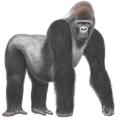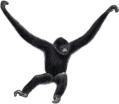Endangered Apes
Every one of the world's 22 species of apes, which include great apes and gibbons, is threatened with extinction.
Here are some of the most endangered apes.
Endangered Great Apes
Great apes all belong to the family Hominidae, which has seven species. Six of the Hominidae species are great apes, each endangered. The only animal in the Homonidae family that isn't an endangered species is humans.
Asia's two species of great ape are orangutans. The Sumatran orangutan, numbering around 6,600 individuals, is the most endangered ape in the world.
In Africa, lowland gorillas are critically endangered, particularly Cross River gorillas, one of two subspecies of lowland gorillas. As well, populations of Africa's other three ape species - chimpanzee, eastern or mountain gorilla, and bonobo or gracile chimpanzee - are all endangered and declining.

Cross River Gorilla
Gorilla gorilla diehli
Cameroon, Nigeria — Somewhere between 200 and 300 Cross River gorillas remain in forests near the border between Cameroon and Nigeria. This great ape subspecies began a sharp decline 200 years ago when hunters acquired guns. Some bushmeat hunting still continues, endangering the group's survival. Rapid cutting of the remaining forest for agriculture also poses a major threat.

Sumatran Orangutan
Pongo abelii
Indonesia — This highly endangered ape species is native only to Sumatra, where about 6,600 individual orangutans are left, all near the island's north end. The rapid logging of rainforests has destroyed orangutan habitat and decimated populations in recent years. With most remaining orangutans living in forests outside of protected parks and reserves, and illegal logging common within protected areas, the world's population of Sumatran orangutans could be halved in a decade.
Endangered Gibbons
All species of gibbons live in Asia and all are threatened. Conservation specialists consider these animals as among the most endangered of gibbon species.

Western Hoolock Gibbon
Hoolock hoolock
Bangladesh, India, Myanmar — The population of this south Asian gibbon has declined by over 90% since the early 1970s when they totalled over 100,000. Today less than 5,000 survive. Between 2001 and 2005 along, western hoolock gibbons disappeared entirely from 18 locations. The gibbons could soon disappear from another 47 sites in India which have fewer than 10 animals left. The forests that western hoolock gibbons require to live are continually being cut and converted into farmland.

Hainan Black-crested Gibbon
Nomascus hainanus
China (Hainan Island) — One of the world's rarest animals, the Hainan black-crested gibbon lives only in forests on the island of Hainan in the South China Sea. They probably numbered over 2,000 during the 1950s. But by 1989 most of their forest was gone, leaving just 21 individuals confined to a nature reserve. The population has stayed at fewer than 20 individuals since then.
Eastern Black-crested Gibbon
Nomascus nasutus
Vietnam, China — The eastern black-crested gibbon, also known as Cao Vit crested gibbon, once ranged widely in northeastern Vietnam and southeastern China. Much of their tropical forests got cut, and by the 1960s these gibbons were considered extinct. Thorough searching by biologists in 2002 discovered a small enclave in Vietnam, and more recently another one in China. Based on 2007 surveys, an estimated 110 eastern black-crested gibbons survive. The endangered apes live in a few remnant patches of forest that are being harvested for firewood and cleared for farming.
References
IUCN 2010. IUCN Red List of Threatened Species. Version 2010.2.
Russell A. Mittermeier, Jonah Ratsimbazafy, Anthony B. Rylands, Liz Williamson, John F. Oates, David Mbora, Jörg U. Ganzhorn, Ernesto Rodríguez-Luna, Erwin Palacios, Eckhard W. Heymann, M. Cecília M. Kierulff, Long Yongcheng, Jatna Supriatna, Christian Roos, Sally Walker and John M. Aguiar. 2007. Primates in Peril: The World's 25 Most Endangered Primates, 2006 - 2008. Primate Conservation. (22): 1-40.
Russell A. Mittermeier, Janette Wallis, Anthony B. Rylands, Jörg U. Ganzhorn, John F. Oates, Elizabeth A. Williamson, Erwin Palacios, Eckhard W. Heymann, M. Cecília M. Kierulff, Long Yongcheng, Jatna Supriatna, Christian Roos, Sally Walker, Liliana Cortés-Ortiz and Christoph Schwitzer. 2009. Primates in Peril: The World's 25 Most Endangered Primates 2008-2010. Primate Conservation (24): 1-57.
Drawings of apes © Conservation International